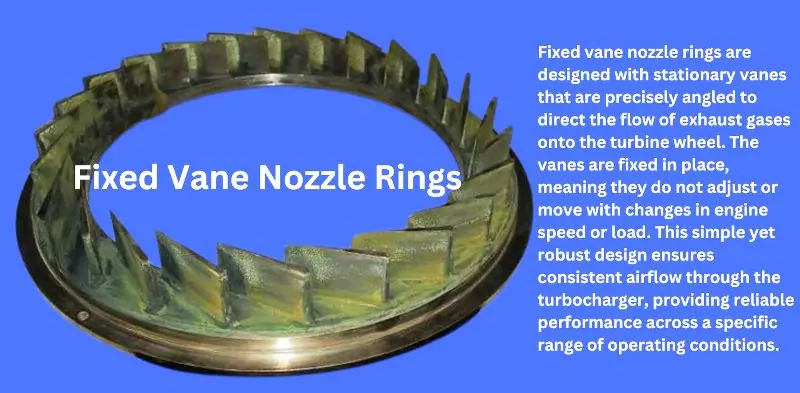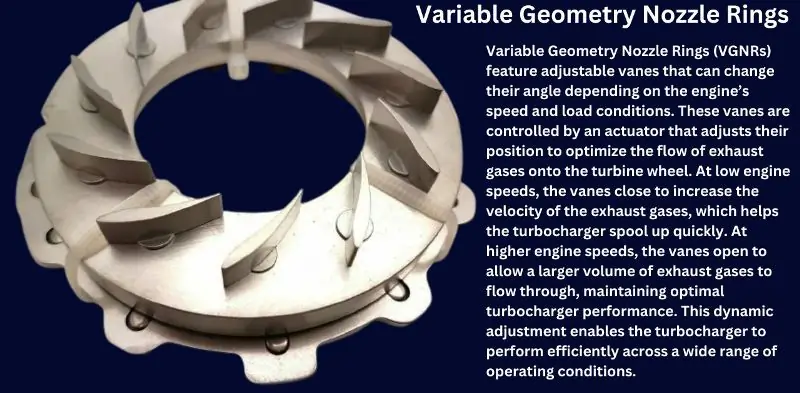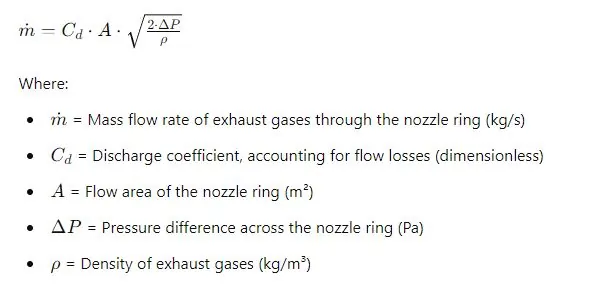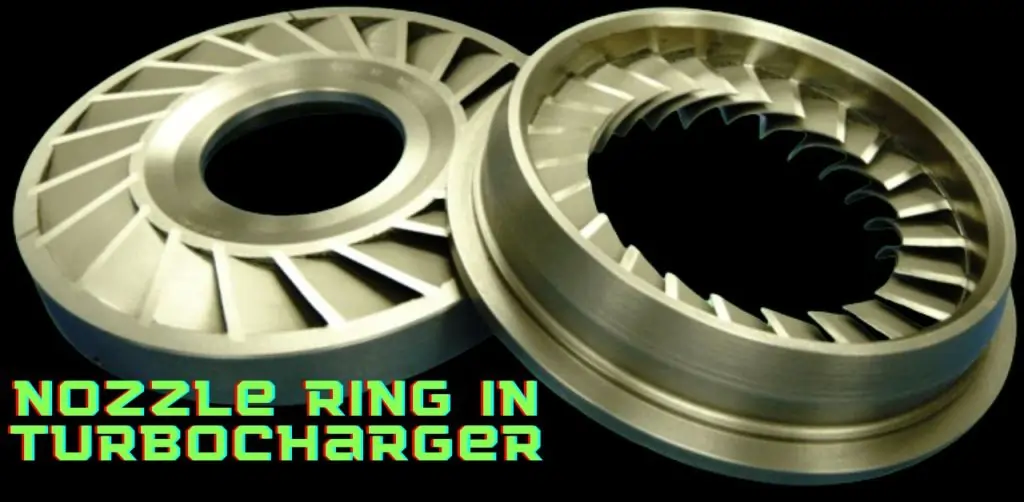Nozzle Ring in Turbocharger
The nozzle ring is a crucial component in turbocharger performance, directing exhaust gases onto the turbine wheel with precision. This small but essential part plays a significant role in enhancing engine efficiency, ensuring that the turbocharger operates at peak performance across various engine speeds. Without a well-designed and properly functioning nozzle ring, the turbocharger cannot efficiently convert exhaust energy into boosted power, leading to reduced engine performance and fuel efficiency.
In this tutorial, we’ll dive deep into the world of nozzle rings, exploring their types, including fixed vane and variable geometry designs, and how they influence turbocharger operation. You’ll also learn about the materials used, installation practices, and maintenance tips to keep your turbocharger running smoothly. By the end of this guide, you’ll have a comprehensive understanding of nozzle rings and their vital role in modern turbocharging technology.
Understanding the Nozzle Ring
Definition and Function: What is a Nozzle Ring in a Turbocharger?
A nozzle ring is a critical component within a turbocharger that guides and directs the flow of exhaust gases onto the turbine wheel. This precise control of gas flow ensures that the turbine spins at the optimal speed, enabling the turbocharger to effectively boost the engine’s power. The nozzle ring’s design is key to maintaining the efficiency of the turbocharger, as it directly influences how the exhaust energy is harnessed.
Types of Nozzle Rings: Fixed Vane vs. Variable Geometry Nozzle Rings
There are two main types of nozzle rings used in turbochargers:
- Fixed Vane Nozzle Rings: These have stationary vanes that are set at a specific angle. They are designed for simplicity and durability, providing consistent performance at a particular operating range. Fixed vane nozzle rings are commonly used in applications where the engine operates within a narrow speed range.
- Variable Geometry Nozzle Rings (VGTs): These feature adjustable vanes that can change their angle based on engine speed and load conditions. This adaptability allows for optimal performance across a wide range of operating conditions, improving efficiency and responsiveness, especially at lower engine speeds.
Nozzle Rings: Impact on Exhaust Gas Flow and Turbo Efficiency
Nozzle rings play a vital role in turbocharger operation by controlling the velocity and direction of exhaust gases as they hit the turbine wheel. The efficiency of this process determines how effectively the turbocharger can convert exhaust energy into mechanical power.
- Optimized Gas Flow: By directing exhaust gases precisely, nozzle rings ensure that the turbine operates at its most efficient point, maximizing boost pressure and engine performance.
- Enhanced Turbocharger Efficiency: Well-designed nozzle rings minimize energy losses, leading to better fuel efficiency and reduced turbo lag, especially in variable geometry systems where the vane angle can be adjusted dynamically.
Fixed Vane Nozzle Rings

Design and Structure: Key Features of Fixed Vane Nozzle Rings
Fixed vane nozzle rings are designed with stationary vanes that are precisely angled to direct the flow of exhaust gases onto the turbine wheel. The vanes are fixed in place, meaning they do not adjust or move with changes in engine speed or load. This simple yet robust design ensures consistent airflow through the turbocharger, providing reliable performance across a specific range of operating conditions. The fixed vanes are typically made from durable, heat-resistant materials such as high-temperature alloys, ensuring they can withstand the harsh conditions within the turbocharger.
Advantages and Limitations of Fixed Vane Nozzle Rings
Advantages:
- Simplicity and Durability: The fixed vane design is straightforward, with fewer moving parts, reducing the potential for mechanical failure. This makes fixed vane nozzle rings highly reliable and easier to maintain.
- Cost-Effective: Fixed vane nozzle rings are generally less expensive to produce and maintain compared to variable geometry designs, making them a cost-effective solution for many applications.
- Consistency: Provides steady and predictable performance within a specific operating range, making them ideal for engines that operate under consistent conditions.
Limitations:
- Limited Flexibility: Since the vanes are fixed, these nozzle rings cannot adjust to varying engine speeds or loads, which can limit performance in dynamic driving conditions.
- Reduced Efficiency at Variable Speeds: Fixed vane nozzle rings are optimized for a specific speed range, which means they may not perform as efficiently across the full spectrum of engine speeds.
Applications of Fixed Vane Nozzle Rings
Fixed vane nozzle rings are commonly used in turbochargers for engines that operate under relatively consistent conditions. Some typical applications include:
- Commercial Diesel Engines: Trucks and heavy machinery that often operate at steady speeds and loads benefit from the reliability and durability of fixed vane nozzle rings.
- Marine Engines: In marine applications, where engines run at a consistent speed for extended periods, fixed vane nozzle rings offer a reliable and low-maintenance option.
- Industrial Engines: Fixed vane nozzle rings are preferred in stationary engines used for power generation or other industrial purposes, where operational conditions are stable and predictable.
Variable Geometry Nozzle Rings

How They Work: The Mechanics of Adjustable Vanes
Variable Geometry Nozzle Rings (VGNRs) feature adjustable vanes that can change their angle depending on the engine’s speed and load conditions. These vanes are controlled by an actuator that adjusts their position to optimize the flow of exhaust gases onto the turbine wheel. At low engine speeds, the vanes close to increase the velocity of the exhaust gases, which helps the turbocharger spool up quickly. At higher engine speeds, the vanes open to allow a larger volume of exhaust gases to flow through, maintaining optimal turbocharger performance. This dynamic adjustment enables the turbocharger to perform efficiently across a wide range of operating conditions.
Performance Benefits: Enhanced Efficiency and Flexibility Across Engine Speeds
- Improved Low-End Torque: By closing the vanes at lower engine speeds, VGNRs help the turbocharger spool up faster, reducing turbo lag and improving low-end torque.
- Optimized Fuel Efficiency: The ability to adjust vane positions allows the turbocharger to operate at peak efficiency across various engine speeds, leading to better fuel economy.
- Reduced Emissions: VGNRs help in maintaining optimal combustion conditions, which can result in lower exhaust emissions, making them beneficial for meeting stringent environmental regulations.
- Broader Power Band: The flexibility of adjustable vanes ensures that the turbocharger can deliver consistent power across a broader range of engine speeds, enhancing overall engine performance.
Applications: Where Variable Geometry Nozzle Rings Excel in Turbochargers
Variable Geometry Nozzle Rings excel in applications where engines operate under a wide range of speeds and loads, providing flexibility and efficiency:
- Passenger Vehicles: VGNRs are commonly used in modern passenger cars, especially in diesel engines, where they help reduce turbo lag and improve fuel efficiency.
- High-Performance Engines: In sports cars and high-performance vehicles, VGNRs are favored for their ability to deliver consistent power and responsiveness across varying driving conditions.
- Commercial Vehicles: For trucks and buses that require both low-speed torque and high-speed efficiency, VGNRs provide the necessary adaptability.
- Marine and Industrial Engines: In scenarios where engines experience fluctuating loads and speeds, such as in marine propulsion or industrial power generation, VGNRs offer superior performance and efficiency.
Mass Flow Rate Calculation Through Nozzle Ring in a Turbocharger
Mass Flow Rate through the nozzle ring, which can be expressed as:

This formula is used to determine the mass flow rate of exhaust gases through the nozzle ring, which directly influences the turbocharger’s ability to convert exhaust energy into mechanical power. Understanding this flow rate is essential for optimizing turbocharger performance and efficiency.
Material Selection for Nozzle Rings
Common Materials Used: Steel, Inconel, Nimonic, and Other High-Temperature Alloys
Nozzle rings in turbochargers are manufactured using materials designed to endure extreme conditions, particularly high temperatures and pressures. Common materials include:
- Steel: Known for its strength and durability, steel is a widely used material in nozzle rings, offering a balance of performance and cost-effectiveness. It is suitable for environments where mechanical stress is a primary concern.
- Inconel: This nickel-chromium-based superalloy is renowned for its exceptional resistance to heat and corrosion. Inconel is often used in turbochargers that experience extreme temperatures, ensuring long-term performance.
- Nimonic: Another nickel-based superalloy, Nimonic is particularly well-suited for high-temperature applications, making it ideal for turbocharger blades and nozzle rings. Its superior heat resistance and creep strength make it a preferred material for components exposed to continuous high-stress conditions.
- Other High-Temperature Alloys: Materials such as titanium or Hastelloy are used in specialized applications where additional strength, heat resistance, or corrosion protection is required.
Material Considerations: Durability, Heat Resistance, and Corrosion Protection
Selecting the right material for nozzle rings involves evaluating several key factors:
- Durability: The chosen material must withstand the mechanical stresses associated with high-speed exhaust gas flow and the forces exerted by the rotating turbine. Durability ensures that the nozzle ring maintains its structural integrity, reducing the frequency of replacements.
- Heat Resistance: Turbochargers operate under extremely high temperatures, particularly on the turbine side. Materials like Inconel and Nimonic are specifically chosen for their ability to retain strength and resist deformation in these harsh environments.
- Corrosion Protection: The exposure to hot, corrosive exhaust gases necessitates materials with high corrosion resistance. Nimonic and Inconel, with their excellent oxidation and corrosion resistance, are ideal choices. Additionally, protective coatings can be applied to further enhance these properties.
Manufacturing Techniques: Precision in Producing Durable Nozzle Rings
Manufacturing nozzle rings with precision is crucial to their performance and longevity:
- Precision Machining: Advanced machining techniques are used to create nozzle rings with tight tolerances and exact specifications, ensuring they fit seamlessly into the turbocharger assembly.
- Heat Treatment: Many materials, including Inconel and Nimonic, undergo heat treatment to enhance their hardness and wear resistance, making them more durable under high-stress conditions.
- Surface Coating: Applying specialized coatings, such as ceramic or metallic layers, can improve the material’s heat resistance and corrosion protection. This additional layer helps extend the service life of the nozzle ring.
- Quality Control: Stringent quality control measures, including dimensional checks and material composition analysis, are critical throughout the manufacturing process to ensure each nozzle ring meets the required standards.
Fixed Vane vs. Variable Geometry Nozzle Rings: A Comparative Analysis
| Criteria | Fixed Vane Nozzle Rings | Variable Geometry Nozzle Rings |
|---|---|---|
| Performance | – Provides consistent airflow optimized for specific engine speeds. – May experience reduced efficiency across varying operating conditions. – Lower responsiveness at low engine speeds, leading to potential turbo lag. | – Adjusts vane angles to optimize airflow across all engine speeds. – Delivers superior efficiency and performance flexibility. – Minimizes turbo lag with improved responsiveness, especially at low speeds. |
| Application Suitability | – Ideal for engines operating under consistent load and speed conditions. – Commonly used in industrial, marine, and some commercial diesel engines. | – Suited for engines with widely varying load and speed requirements. – Widely utilized in passenger vehicles, high-performance cars, and modern diesel engines. |
| Cost and Maintenance | – Lower initial cost due to simpler design and manufacturing processes. – Easier and less expensive to maintain with fewer moving parts. – Longer service intervals and reduced risk of mechanical failure. | – Higher initial cost owing to complex design and advanced materials. – Requires more frequent and specialized maintenance. – Potential for increased repair costs due to intricate moving components. |
Installation and Maintenance of Nozzle Rings
| Category | Details |
|---|---|
| Installation Best Practices | Cleanliness is Critical: Ensure all components are thoroughly cleaned before installation to prevent misalignment or damage. Correct Positioning: Align the nozzle ring precisely for optimal exhaust gas flow onto the turbine wheel. Proper Fastening: Use manufacturer-specified torque settings to secure the nozzle ring, avoiding over-tightening or under-tightening. Lubrication: Apply the correct type and amount of lubricant if required to reduce friction and prevent wear. |
| Common Issues and Troubleshooting | Noise and Vibration: Misalignment or wear can cause unusual noises or excessive vibration; inspect and realign or replace as needed. Reduced Performance: A clogged or damaged nozzle ring can decrease turbocharger efficiency; clean or replace it if necessary. Leakage: Oil or exhaust gas leaks may indicate a failed seal or improper installation; check seals and ensure the nozzle ring is seated correctly. |
| Maintenance Tips | Regular Inspections: Periodically inspect the nozzle ring for wear, damage, or carbon buildup to prevent larger issues. Cleaning: Keep the nozzle ring free from carbon deposits and debris using appropriate cleaning agents. Monitor Operating Conditions: Ensure the engine operates within recommended parameters to avoid excessive wear on the nozzle ring. Replace When Necessary: Replace the nozzle ring according to the manufacturer’s schedule or when significant wear is observed. |
Optimal Nozzle Ring Angles and Blade Thickness Guidelines
Nozzle Ring Angles
- Inlet Angle (Leading Edge): Typically ranges between 15° to 30° relative to the direction of the incoming exhaust gases. This angle helps in guiding the exhaust gases onto the turbine blades effectively.
- Outlet Angle (Trailing Edge): Usually between 30° to 60°, which is designed to optimize the exit flow of gases, reducing turbulence and maximizing energy transfer to the turbine wheel.
Blade Thickness
- Leading Edge Thickness: Typically around 0.8 mm to 2 mm, depending on the material and the design. A thinner leading edge reduces aerodynamic drag and improves flow efficiency.
- Mid-Section Thickness: Varies between 2 mm to 5 mm, depending on the material’s strength and the load it needs to withstand. This section must balance durability with minimal flow restriction.
- Trailing Edge Thickness: Often between 0.5 mm to 1.5 mm. A thinner trailing edge reduces wake and improves the smoothness of the exhaust gas flow as it exits the nozzle ring.
Conclusion
In conclusion, understanding the intricacies of nozzle rings, including their design, material selection, installation, and maintenance, is essential for maximizing turbocharger efficiency and engine performance. Whether dealing with fixed vane or variable geometry designs, the right approach can significantly enhance your turbocharger’s lifespan and reliability. By applying the insights shared in this tutorial, you can ensure your turbocharger operates at peak performance, contributing to a more powerful and efficient engine.
FAQs on Nozzle Ring in Turbocharger
Q- What is the primary function of a nozzle ring in a turbocharger?
A- It directs exhaust gases onto the turbine wheel to enhance efficiency.
Q- How does a fixed vane nozzle ring differ from a variable geometry nozzle ring?
A- Fixed vane rings have stationary vanes; variable geometry rings have adjustable vanes.
Q- What materials are commonly used in the production of nozzle rings?
A- Common materials include Inconel, Nimonic, and steel for durability and heat resistance.
Q- What are the signs of a faulty nozzle ring in a turbocharger?
A- Signs include unusual noises, vibration, reduced efficiency, and leaks.
